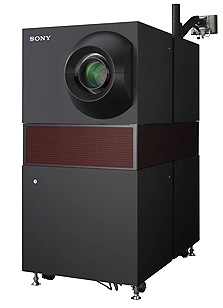Digital Cinema Projection (or Digital Cinema, for short) is a method whereby the traditional film containing the movie is replaced by an electronic copy contained on a storage device, such as a high-capacity hard drive and server. Instead of projecting light through film, digital cinema utilizes technologies such as DLP and LCOS to accomplish the task.
 Digital Cinema is a new technology that is poised to spread in popularity in the movie industry. "Star Wars Episode II: Attack of the Clones" was the first all-digital live action feature, no film was used in the creation of that movie until film copies had to be made for theaters without Digital Cinema projectors. Many filmmakers (a term that is nearing a level of obsolesence) are using, or are considering using, digital technologies to create their movies. George Lucas (Star Wars movies, et al) has stated that his future films will be shot digitally, and Robert Rodriguez (Spy Kids, et al.) used digital cinema cameras to create "Once Upon a Time in Mexico."
Digital Cinema is a new technology that is poised to spread in popularity in the movie industry. "Star Wars Episode II: Attack of the Clones" was the first all-digital live action feature, no film was used in the creation of that movie until film copies had to be made for theaters without Digital Cinema projectors. Many filmmakers (a term that is nearing a level of obsolesence) are using, or are considering using, digital technologies to create their movies. George Lucas (Star Wars movies, et al) has stated that his future films will be shot digitally, and Robert Rodriguez (Spy Kids, et al.) used digital cinema cameras to create "Once Upon a Time in Mexico."
Is Digital Cinema Better Than Traditional Film?
While the technologies behind Digital Cinema do not yet meet the image resolution capability of film, our experience has shown that many theaters showing traditional film presentations do not meet the capability of film either.
When comparing the average film presentation to the average digital cinema presentation, we have found that the digital cinema presentation was equal in picture quality and was a more stable image than film. While some complain of seeing artifacts, we have not observed problems with the presentations we've seen. Digital presentations do not get scratched, fade, or suffer the other problems that film experiences, especially after being played for an extended time. The picture and sound should be as good on day 100 as they were on day 1.
Because of this, we believe that Digital Cinema presentations improve the movie-going experience, and we are happy to identify those presentations in a special way in our publication.
2K vs. 4K Systems
Sony SXRD Digital Cinema ProjectorThe first Digital Cinema installations were 1.3K systems, but those are no longer approved for use. Most Digital Cinema installations are 2K installations, with a resolution of 2048 pixels by 1080 pixels (HDTV's are 1920x1080 or 1280x720).
Sony Electronics was the first to introduce 4K systems, which display images that are 4096 pixels by 2160 pixels. Texas Instruments is also making 4K equipment for movie theaters. Sony's equipment is marketed under the brand of CineAlta™ SXRD™ 4K Digital Cinema, so if you see a showtime marked as "SXHD" that means that it's a 4K presentation.

Does this mean that 4K installations are twice as good as 2K installations?
Actually, the math works out to four times as many pixels present in a 4K image than a 2K image. Regardless, the answer to the question is "maybe, it depends."
Many movies are digitized at the 2K resolution and their special effects are also rendered at that resolution. It is very difficult to find out which movies might be produced using 4K resolutions, and there probably would be little to no benefit to viewing a 2K movie on a 4K system over a 2K system.
It is future-proofing, though, as technology always progresses, and studios will most certainly invest in higher resolution equipment as time goes on and especially if 4K-capable projection systems become popular.Here in July 2008, there is talk about restoring movies using 6K scanners, so the technology is certainly present to capture very high resolution images from film, and rarely is more resolution a bad thing when it comes to image quality.
Digital Cinema Makes 3D Better and Easier
The advent of digital cinema projection systems has brought about a rebirth of 3D efforts on the part of the movie studios. Previously, 3D using 35mm film was a tedious process to project and you were limited to wearing those odd-looking red and blue 3D glasses. Today's 3D Digital Cinema systems still use glasses, but they are mostly clear and are capable of delivering a better 3D experience than the old red-blue "anaglyph" process.
 IMAX Digital Cinema
IMAX Digital Cinema
Long known for its amazingly large screens and gigantic projectors and the film used to project documentaries in museums and mainstream movies in movie theaters under the "IMAX Experience" moniker, IMAX Corporation has begun switching from film-based systems to Digital Cinema systems as well.
IMAX Digital Cinema installations use two 2K projectors and some proprietary image processing to project the image onto the screen. IMAX Digital screen sizes range from 47' x 24' to 74' x 46', which are not as large as film-based IMAX screens can be. Both 2D and 3D presentations can be shown.
How to Identify Digital Cinema Presentations
3D Digital Cinema Projection LogoDigital Cinema Projection LogoWhen theaters include indicators for Digital Cinema presentations, we mark their showtimes with the logos to the right. Now that Digital Cinema installations are being used for 3D presentations, we have a separate logo (the one on the right) for Digital Cinema 3D presentations.
Does Digital Cinema Mean a Perfect Presentation?
While there won't be film-related issues, like scratched prints, sound dropouts, and jump and weave, there are still other problems that can arise. Theaters must still have qualified staff and well-maintained equipment, and digital projection surely isn't going to keep the floor clean or the popcorn tasting good.
But we hope that theaters that make the investment in digital projection equipment care enough for their customers to pay attention to all aspects of the movie-going experience.
Why Don't All Theaters Have Digital Cinema Projection?
Digital cinema technology is still in its infancy and, like all new technologies, it can be expensive. Theaters and movie studios are negotiating to determine how they can divide the costs of the equipment so that more theaters can  provide this new technology for their customers.
provide this new technology for their customers.
Are There Any Other Benefits to Digital Cinema?
Ideally, theaters that have digital cinema technology installed do not have to worry about building film prints, moving them from screen to screen, and even being limited to a fixed number of screens in which to play a movie. Simply put, the day's shows can be queued up much like a playlist on an MP3 player, along with the trailers to be shown, and associated advertisements they may be running. The equipment would also allow theaters to deliver other entertainment, such as concert events, live broadcasts, etc. Imagine going to the theater to see your favorite football team in HDTV on a 35-foot screen and digital surround sound!
